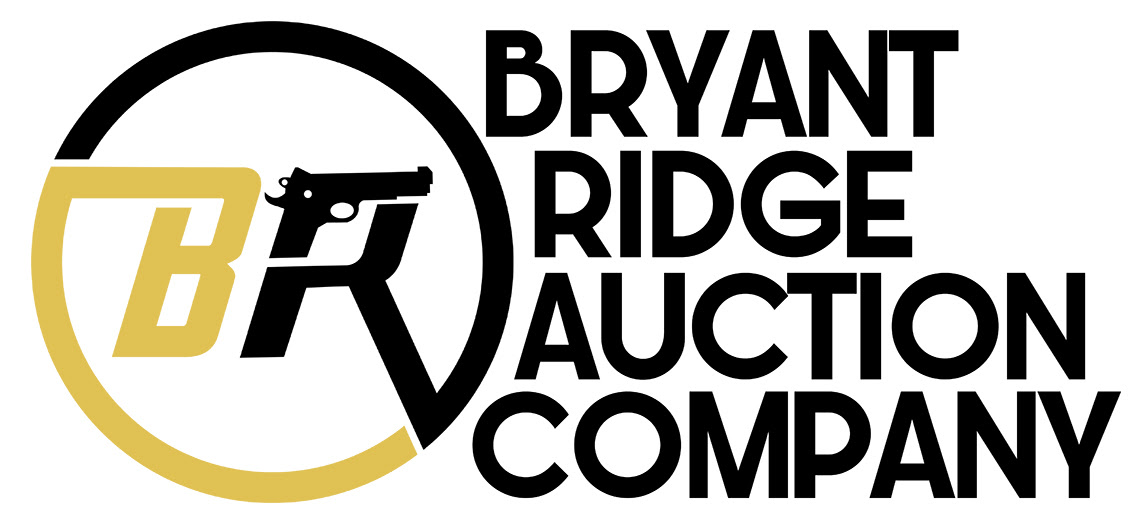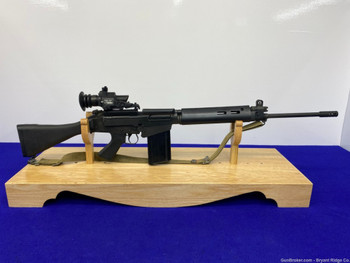Description

Item Description
Bryant Ridge Auction Company is pleased to present this semi-auto rifle today for a penny start auction; this is the Century Arms L1A1 Sporter!
SPECIFICATIONS:
Manufacturer: Century Arms
Model: L1A1 Sporter
Serial: 103092
Caliber: .308
Finish: Parkerized
Barrel Length: 20" with Flash Suppressor
Optics/Sights: Wing Protected Blade Front with Folding Peep Rear and Mounted Sightunit Infantry Trilux L2A2 Scope
Stock/Grips: Black Synthetic Thumbhole Stock and Forearm
Action: Semi-Auto
Markings: Standard
Bryant Ridge's Analysis:
Most Commonwealth pattern FALs are semi-automatic only. A variant named L2A1/C2A1 (C2) meant to serve as a light machine gun in a support role, is also capable of fully automatic fire. Differences from the L1A1/C1 include a heavy barrel, squared front sight (versus the "V" on the semi-automatic models), a handguard that doubles as a foldable bipod, and a larger 30-round magazine. However, it could also use the normal 20-round magazines. Only Canada and Australia used this variant. Australia, New Zealand, and the United Kingdom used the Bren light machine guns converted to fire the 7.62×51mm NATO cartridge for use in the support role. Canadian C1s issued to naval and army personnel were also capable of fully automatic fire.
The SUIT sight is a 4× prism sight with tritium-powered illumination, utilized at dusk or dawn. The full name is the L2A2 Sight Unit Infantry Trilux. The sight is not designed as a sniper sight but as a standard issue infantry sight to improve the infantryman's night fighting capability and to assist target identification at long range in daylight and in poor light conditions. The sight was mounted on the L1A1 Self-Loading Rifle or GPMG. The SUIT sight was developed in the United Kingdom by Royal Armaments Research Development Establishment (RARDE) and is manufactured by Avimo Ltd., now known as Thales UK. It was first produced in 1976 by Avimo Ltd. in London and is regarded as an early optical combat sight. The SUIT sight was an optional optical sighting system for the British Army's L1A1 Self-Loading Rifle and was also used by the Australians and New Zealanders. It was not widely issued amongst nor used in combat by the British Infantry, Royal Marines and RAF Regiment.
Return Policy:
We gladly offer a 3 day unfired inspection policy from the time that the firearm is delivered to your FFL. Refunds are available for all qualifying orders.
Model: L1A1 Sporter
Serial: 103092
Caliber: .308
Finish: Parkerized
Barrel Length: 20" with Flash Suppressor
Optics/Sights: Wing Protected Blade Front with Folding Peep Rear and Mounted Sightunit Infantry Trilux L2A2 Scope
Stock/Grips: Black Synthetic Thumbhole Stock and Forearm
Action: Semi-Auto
Markings: Standard
Bryant Ridge's Analysis:
The L1A1 Self-Loading Rifle (SLR), also known by the initial Canadian designation C1, or in the U.S. as the "inch pattern" FAL, is a British version of the Belgian FN FAL battle rifle. The L1A1 was produced under license and adopted by the armed forces of the United Kingdom, Australia, Canada, India, Jamaica, Malaysia, New Zealand, Rhodesia, and Singapore. The L1A1 is manufactured to a slightly modified design using British imperial units compared to the metric units of the original Belgian FAL. Many sub-assemblies are interchangeable between the two types, while components of those sub-assemblies may not be compatible. Notable incompatibilities include the magazine and the stock.
Most Commonwealth pattern FALs are semi-automatic only. A variant named L2A1/C2A1 (C2) meant to serve as a light machine gun in a support role, is also capable of fully automatic fire. Differences from the L1A1/C1 include a heavy barrel, squared front sight (versus the "V" on the semi-automatic models), a handguard that doubles as a foldable bipod, and a larger 30-round magazine. However, it could also use the normal 20-round magazines. Only Canada and Australia used this variant. Australia, New Zealand, and the United Kingdom used the Bren light machine guns converted to fire the 7.62×51mm NATO cartridge for use in the support role. Canadian C1s issued to naval and army personnel were also capable of fully automatic fire.
The SUIT sight is a 4× prism sight with tritium-powered illumination, utilized at dusk or dawn. The full name is the L2A2 Sight Unit Infantry Trilux. The sight is not designed as a sniper sight but as a standard issue infantry sight to improve the infantryman's night fighting capability and to assist target identification at long range in daylight and in poor light conditions. The sight was mounted on the L1A1 Self-Loading Rifle or GPMG. The SUIT sight was developed in the United Kingdom by Royal Armaments Research Development Establishment (RARDE) and is manufactured by Avimo Ltd., now known as Thales UK. It was first produced in 1976 by Avimo Ltd. in London and is regarded as an early optical combat sight. The SUIT sight was an optional optical sighting system for the British Army's L1A1 Self-Loading Rifle and was also used by the Australians and New Zealanders. It was not widely issued amongst nor used in combat by the British Infantry, Royal Marines and RAF Regiment.
Return Policy:
We gladly offer a 3 day unfired inspection policy from the time that the firearm is delivered to your FFL. Refunds are available for all qualifying orders.
Shipping Details
Handgun Standard Shipping $50.00
Long Gun Standard Shipping $70.00
Any orders placed with magazines that are not compliant with your state, county, or city regulations will not ship with your order.
















